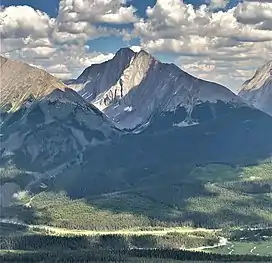The Tower (Alberta)
The Tower is the unofficial name for a large prominent peak that sits above Rummel Lake. It is located between Mount Engadine and Mount Galatea of the Kananaskis Range in Alberta, Canada.[2][3]
| The Tower | |
|---|---|
 West aspect, viewed from Tent Ridge | |
| Highest point | |
| Elevation | 3,117 m (10,226 ft)[1][2] |
| Prominence | 618 m (2,028 ft)[2] |
| Parent peak | Mount Bogart (3144 m)[2] |
| Listing | Mountains of Alberta |
| Coordinates | 50°51′24″N 115°17′22″W[2] |
| Geography | |
 The Tower Location in Alberta | |
| Country | Canada |
| Province | Alberta |
| Parent range | Kananaskis Range |
| Topo map | NTS 82J14 Spray Lakes Reservoir |
| Climbing | |
| First ascent | Unknown[2] |
Geology
The Tower is composed of sedimentary rock laid down during the Precambrian to Jurassic periods.[4] Formed in shallow seas, this sedimentary rock was pushed east and over the top of younger rock during the Laramide orogeny.[5]
Climate
Based on the Köppen climate classification, The Tower is located in a subarctic climate zone with cold, snowy winters, and mild summers.[6] Temperatures can drop below −20 °C with wind chill factors below −30 °C.
References
- "Topographic map of The Tower". opentopomap.org. Retrieved 2022-01-14.
- "The Tower". Bivouac.com. Retrieved 2022-01-14.
- "The Tower". cdnrockiesdatabases.ca. Retrieved 2022-01-14.
- Belyea, Helen R. (1960). The Story of the Mountains in Banff National Park (PDF). parkscanadahistory.com (Report). Ottawa: Geological Survey of Canada. Archived (PDF) from the original on 2015-10-02. Retrieved 2019-09-13.
- Gadd, Ben (2008). Geology of the Rocky Mountains and Columbias.
- Peel, M. C.; Finlayson, B. L.; McMahon, T. A. (2007). "Updated world map of the Köppen−Geiger climate classification". Hydrol. Earth Syst. Sci. 11: 1633–1644. ISSN 1027-5606.
This article is issued from Wikipedia. The text is licensed under Creative Commons - Attribution - Sharealike. Additional terms may apply for the media files.